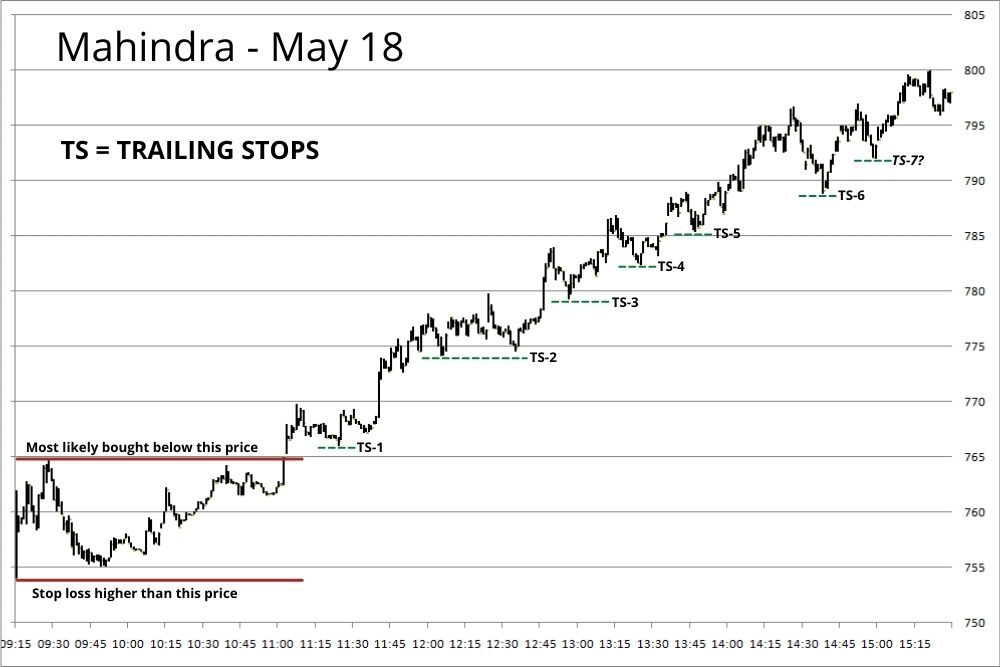TRADING & INVESTING STRATEGIES
Online Course
REGISTER NOW
For greater trading profits, use trailing stops, not targets
Posted: May 28, 2025 00:50
SHARE
Many day traders use targets to exit day trades with a profit. Whilst this is very convenient, targets miss out on much larger profits when there is a strong move.
Traders typically place targets 1-2% from their entry price. Market advisors often set even smaller targets to improve their chances of being proven right.
Why Trailing Stops Beat Targets
A more profitable way of trading is to use trailing stops instead of targets. A trailing stop is like a stop loss, except that it results in a profit rather than a loss.
Here is how to trade using trailing stops for a long (buy) trade. When you enter your trade, place a stop loss sell order as planned. If the stock starts rising, raise the stop loss order to a higher level. Keep raising this level as the stock keeps going up. The stock will eventually fall below one of these trailing stops, or will close with a substantial profit.
Practical Methods for Setting Trailing Stops
There are different ways of arriving at trailing stops. One way, for instance, is to protect a certain percentage of your maximum unbooked profit.
Another method, favoured by chartists, is to pick bottoms from charts as they form during the day. You can see these in the chart which has been picked for this article (Mahindra, 18th May 2021). Trailing stops were continuously raised as higher bottoms formed. Bottoms were selected only if the price remained above them for at least 30 minutes.
As the market approaches the closing, the 30 minute cutoff could be reduced. TS-7 is one such bottom which could be used as a trailing stop without waiting for 30 minutes.
Please note that the 30-minute interval is not a trading rule! You could pick your own number.
Timeless Principle, Broader Application
Whilst this Mahindra example is from 2021, the trailing stop concept remains as relevant today as ever. Market psychology and momentum patterns haven't changed—strong moves still tend to continue longer than most traders expect.
More importantly, this technique isn't limited to day trading. Swing traders holding positions for days or weeks can apply the same principle, using daily chart patterns to set trailing stops rather than intraday levels. The timeframe changes, but the logic remains: let winners run whilst protecting gains.
Real Impact on Returns
You will not catch moves like Mahindra's every day, but they are frequent enough to boost your profits. In this instance, we would get a 5% gain instead of just over 1%.
The chart shows two maroon lines at the start of the session. It is very likely that traders would have bought the stock and placed their initial stop loss somewhere between the two lines.
The Reality Check
Do bear in mind that most day traders get negative annual returns. Various studies have shown that at least 90% make losses. So, day trading is certainly not something you should give up your job for!
To break into the 10% who do make profits, tweaks like trailing stops can make a significant difference. Risk and money management - not rigorously practised by most traders - is another critical factor.
The Academic Foundation
Research supports letting winners run. Studies show that successful traders typically have higher win rates on large moves than small ones, suggesting that position management techniques like trailing stops contribute materially to long-term profitability.
This approach aligns with momentum principles documented in academic literature, where trends often persist longer than most traders expect.
For those serious about improving their trading results through evidence-based techniques, we have included day-trading strategies among the ones that work in Deepak Mohoni's Trading and Investing Strategies online course, including live day-trading exercises with trailing stops, plus momentum investing strategies backed by decades of academic research. You'll get direct feedback on your trades and access to proven Google Sheets tools for ongoing analysis.
REGISTER NOW and learn all the ropes!
More stories about:
Trading
Blog
Comments
-
Libordbroking Jun 10, 2021 11:16
Thanks for sharing the blog, seems to be interesting and informative too. Avail hassle free paperless demat account opening online at Libord Broking with cross trading platform, easy on the pocket and paperless account opening. Click now to open demat account Instantly & start trading -
Libordbroking Jun 10, 2021 11:16
Thanks for sharing the blog, seems to be interesting and informative too. Avail hassle free paperless demat account opening online at Libord Broking with cross trading platform, easy on the pocket and paperless account opening. Click now to open demat account Instantly & start trading.